

Each type of soil and climate will favor different combinations of plants. Heath plants are known to grow best on acidic substrates. Here are 8 heath plants that stand out thanks to their spectacular blooming.
Heath soil is a type of soil that appears naturally in some parts of the country, wherever the ground is light, sandy, rich and acidic. Often, pine trees and heather grow there, hence the name of this substrate. In garden stores, heath soil is for sale in large bags. It reproduces the forest soil by mixing shredded pine bark, sand, peat, compost, sandy soil and crushed horns.
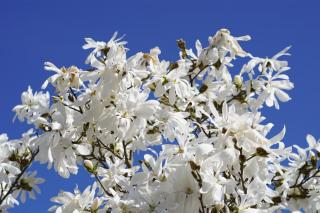 If your soil is naturally acidic, you can plant these species directly in the ground. Try them out in garden beds, as standalones, in hedges… These plants often bloom abundantly, are often evergreens, and make great additions to your garden. If the soil is neutral instead, simply supplement with heath soil that you can purchase in stores before planting. If your garden soil is alkaline, however, you’ll have to go for pots! Once that’s cared for, next comes exposure: most of these plants prefer part shade, even full shade.
If your soil is naturally acidic, you can plant these species directly in the ground. Try them out in garden beds, as standalones, in hedges… These plants often bloom abundantly, are often evergreens, and make great additions to your garden. If the soil is neutral instead, simply supplement with heath soil that you can purchase in stores before planting. If your garden soil is alkaline, however, you’ll have to go for pots! Once that’s cared for, next comes exposure: most of these plants prefer part shade, even full shade.
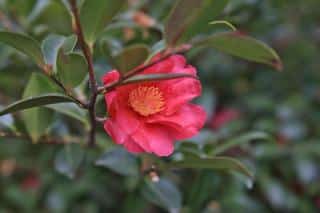 Ever heard of these three before? Of course! These shrubs are always the first three to appear on any heath plant list. They’re so easy to pair together, their colors are simply stunning and wonderful! All three have varieties that bear oval evergreen leaves, often a shiny dark green sheen. As for flowers, it’s a true festival season after season.
Ever heard of these three before? Of course! These shrubs are always the first three to appear on any heath plant list. They’re so easy to pair together, their colors are simply stunning and wonderful! All three have varieties that bear oval evergreen leaves, often a shiny dark green sheen. As for flowers, it’s a true festival season after season.
You’ll have a hard time picking the right ones, since there are so many to choose from for these ornamental shrubs. We’ll just mention the magnificent lavender-colored blooms of the Rhododendron impeditum, intense pink of the ‘Silver Queen’ azalea, and the elegant white blooming of the Camellia japonica ‘Nobilissima’. This last variety, just like the ‘Fairy Wand’ Camellia, truly lights up the garden in Winter.
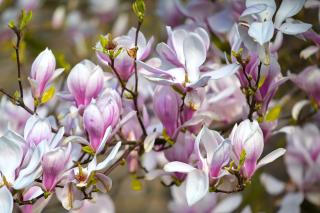 The star of Spring, one of the first to bloom. Magnolia, of course! The earliest blooming species is Magnolia stellata. It definitely deserves its name thanks to its white star-shaped flowers. Right up after it blooms the Magnolia soulangeana which entertains us with pink-hued blooms. Peaking out at 20 feet tall (6 m), it’s also well-suited to small gardens!
The star of Spring, one of the first to bloom. Magnolia, of course! The earliest blooming species is Magnolia stellata. It definitely deserves its name thanks to its white star-shaped flowers. Right up after it blooms the Magnolia soulangeana which entertains us with pink-hued blooms. Peaking out at 20 feet tall (6 m), it’s also well-suited to small gardens!
As for taller trees, let’s take a look at the Japanese dogwood. It’s the one shown at the top of this article, the feature picture. This particular species loves acidic soil and has unique, one-of-a-kind flowers. Actually, they’re not quite flowers: the large petal-like structures are bracts, which are special leaves that took on part of the flower’s job. The four bracts are perfectly aligned around the heart, which is the actual, real flower. All together, it looks like a designer created a flower from scratch!
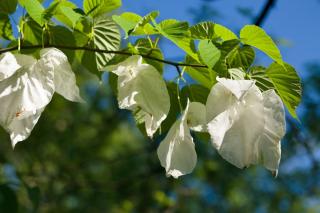 Talking about ornamental bract plants, heath plants sure have a boatload of them!
Talking about ornamental bract plants, heath plants sure have a boatload of them!
Let’s take a closer look at the handkerchief tree. Doesn’t its name suit it well?
This acidic-soil-loving tree is dappled all over with white bracts that look like hanging handkerchiefs, truly stunning!
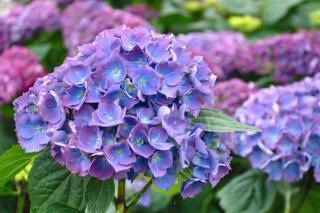 From June to September, hydrangea thrusts its round, conical or umbrella-shaped flowers all around. It serves as a natural pH tester, since the blooming turns blue in acidic soil. If it grows to have pink flowers, it means the soil is alkaline! An easy plant to live with, hydrangea will quickly fill in the back of a flower bed or a hedge. It seems created to grow around old, vintage, traditional homes, and nonetheless will look amazing in a modern, cubic house, too! This hardy shrub requires part shade and soil that stays cool. Upon planting, make sure you soak the clump in a pail of water. In Spring of every year, add organic fertilizer to keep the blooming on par.
From June to September, hydrangea thrusts its round, conical or umbrella-shaped flowers all around. It serves as a natural pH tester, since the blooming turns blue in acidic soil. If it grows to have pink flowers, it means the soil is alkaline! An easy plant to live with, hydrangea will quickly fill in the back of a flower bed or a hedge. It seems created to grow around old, vintage, traditional homes, and nonetheless will look amazing in a modern, cubic house, too! This hardy shrub requires part shade and soil that stays cool. Upon planting, make sure you soak the clump in a pail of water. In Spring of every year, add organic fertilizer to keep the blooming on par.
Remember to give them a regular dose of pine bark mulch, it’ll keep the soil rich and perfectly acidic!